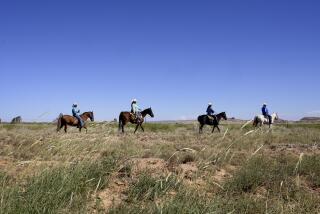Cultivating Gardens of Self-Sufficiency
SELLS, Ariz. â Margaret Saraficioâs garden produced enough squash this fall for seven meals. To her that meant seven times she didnât have to spend money at the store.
But for the crows, she grumbles, the yield would have been even higher.
âI donât buy squash anymore,â Saraficio says as she shows off her one-acre patch, now plowed under for winter. âI like to plant. I think itâs healthier.â
Saraficio, a 64-year-old basket weaver, is one of dozens of people on the Tohono Oâodham Indian Reservation who cultivated gardens this year as part of a federally funded program to overcome the lack of food in poor communities.
The program is sponsored by the U.S. Department of Agriculture, which last month said 10 million American families had inadequate access to food from 1996 to 1998. Arizona ranked fourth in the nation, with 12.8% of its households, or 228,000 families, threatened with hunger.
The Tohono Oâodham know what it means to be hungry.
In the old days, gardens, not grocery stores, dominated the landscape of the sprawling reservation in southern Arizonaâs Sonoran Desert. The harvest was bountiful during the summer, but barren in winter.
âOne old man told me, âI remember when we used to have just a piece of tortilla, and thatâs what we survived on during the hunger time,ââ says Art Wilson, cultural coordinator for the tribeâs elder program.
Still, traditional gardening sustained the community until World War II took the men from their families and a devastating drought struck a few years later. One by one the gardens died off, and the native food system was replaced with government commodities.
Today, with 66% of the reservationâs 18,000 residents living in poverty, commodities and food stamps provide most of the meals for the Tohono Oâodham.
But there is another problem: More than 50% of the tribeâs adults have diabetes, a plight blamed on the destruction of the traditional food system and diet.
The Tohono Oâodham Community Food System project looks to return to the traditional ways, to improve both the availability and nutritional value of food on the reservation.
âSome people say, âIsnât this just nostalgic?â Itâs literally a matter of physical and cultural survival,â says Tristan Reader, co-director of Tohono Oâodham Community Action or TOCA, which won an $80,000 USDA grant for the project.
This summer TOCA volunteers helped 50 families plant gardens using seeds for traditional foods such as corn, squash and tepary beans, a heat-tolerant crop that can help regulate blood sugar. They provided tools, fencing and, for elderly gardeners such as Saraficio, labor.
TOCA also is sponsoring field trips to collect food from the wild, including beans from mesquite trees, saguaro cactus fruit and acorns. Additionally, schoolchildren participate in a weekly food program at the reservationâs community garden, planted in 1996 next to the hospital in Sells.
At the heart of the project, says Reader, is the idea that defeating hunger takes more than ensuring that families have enough food. Itâs about having the right foods, both nutritionally and culturally.
âEven for people who might have enough in their stomach when they go to bed, their bodies are still starving because theyâre the wrong foods,â he says. âThe solution is here. Itâs in the communityâs hands.â
More to Read
Sign up for Essential California
The most important California stories and recommendations in your inbox every morning.
You may occasionally receive promotional content from the Los Angeles Times.










